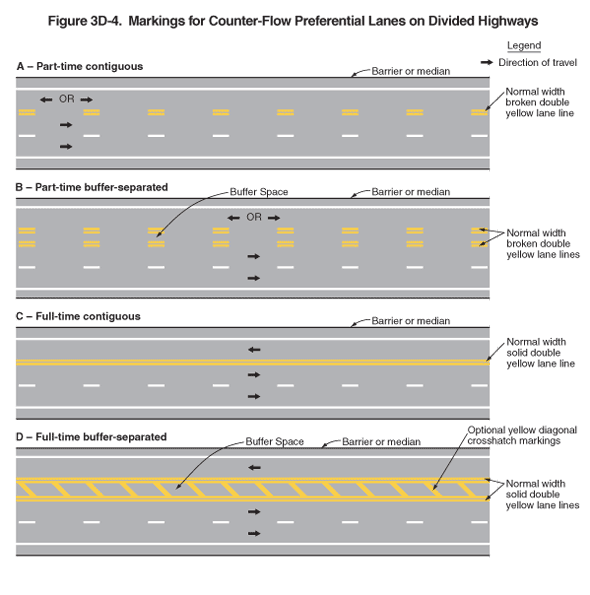2009 Edition Part 3 Figure 3D-4. Markings for Counter-Flow Preferential Lanes on Divided Highways

Figure 3D-4. Markings for Counter-Flow Preferential Lanes on Divided Highways
This figure illustrates four examples of markings for counter-flow preferential lanes on divided highways.
Four horizontal roadways are shown, A, B, C, and D. A legend shows a black arrow indicating the direction of travel in the lanes.
- Figure A, part-time contiguous, shows a three-lane roadway. A solid yellow line separates the left travel lane from a shoulder, a solid white line separates the right travel lane from a shoulder, and a broken white line separates the two rightmost lanes from each other. The left shoulder is bordered on the outside by a line labeled "barrier or median." The left preferential lane is separated from the two through lanes by a normal width broken double yellow lane line. The left preferential lane is shown with a left-facing black arrow, the word "OR," and a right-facing black arrow, denoting travel in either direction. The other two lanes are shown with right-facing black arrows, denoting the direction of travel.
- Figure B, part-time buffer-separated, shows a three-lane roadway. A solid yellow line separates the left travel lane from a shoulder, a solid white line separates the right travel lane from a shoulder, and a broken white line separates the two rightmost lanes from each other. The left shoulder is bordered on the outside by a line labeled "barrier or median." The left preferential lane is separated from the two through lanes by a normal width broken double yellow lane line to the right of the preferential lane, a buffer space, and another normal width broken double yellow lane line to the left of the left through lane. The left preferential lane is shown with a left-facing black arrow, the word "OR," and a right-facing black arrow, denoting travel in either direction. The other two lanes are shown with right-facing black arrows, denoting the direction of travel.
- Figure C, full-time contiguous, shows a three-lane roadway. A solid yellow line separates the left travel lane from a shoulder, a solid white line separates the right travel lane from a shoulder, and a broken white line separates the two rightmost lanes from each other. The left shoulder is bordered on the outside by a line labeled "barrier or median." The left preferential lane is separated from the two through lanes by a normal width solid double yellow lane line. The left preferential lane is shown with a left-facing black arrow, and the other two lanes are shown with right-facing black arrows, denoting the direction of travel.
- Figure D, full-time buffer-separated, shows a three-lane roadway. A solid yellow line separates the left travel lane from a shoulder, a solid white line separates the right travel lane from a shoulder, and a broken white line separates the two rightmost lanes from each other. The left shoulder is bordered on the outside by a line labeled "barrier or median." The left preferential lane is separated from the two through lanes by a normal width solid double yellow lane line to the right of the preferential lane, a buffer space, and another normal width solid yellow lane line to the left of the left through lane. The buffer space is shown with optional yellow diagonal crosshatch markings. The left preferential lane is shown with a left-facing black arrow, and the other two lanes are shown with right-facing black arrows, denoting the direction of travel.
